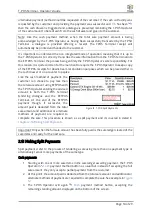
T-POS Terminal -
Operator’s Guide
Page 4 of 29
2.2
Getting Started
After unpacking the T-POS System, making all the necessary connections (covered in
chapter
) and powering it on for the very first time,
it’s time to
get familiarised
with the system and take the first steps to customising it to your requirements.
While this chapter will help give you an overview of the steps, there are chapters dedicated to
specific topics to assist you, however some of these steps may have already been done for you
in the factory prior to shipment, if the T-POS system was staged for your specific deployment:
•
Licensing
•
Configuration.
•
General.
•
Forecourt.
•
Receipt.
•
Establish Product Catalogue & Inventory.
•
Start T-POS Day.
Licensing: Although TPOS should have been licensed for you when the system was staged in
the factory prior to shipment,
if however, a license is absent, the Operator is advised of this
on starting the TPOS Terminal. Please be warned that without a license, while most operations
are allowed with the exception of tendering sales, the TPOS Terminal is rendered to no
practical use. A TPOS Operator will need to provide the installation key (found in the License
Properties dialog) to TT Fuel who in return, will provide a license key and which should be
entered there also.
To receive a valid license key, make sure you first provide TT Fuel with the installation key then
proceed unlocking the full T-POS functionality by entering it in the License dialogue:
Menu
→
Settings
→
License
.
Configuration: There are three aspects to configuration that need addressing and it does not
matter in which order these are tackled. For simplicity and to quickly get acquainted with the
touch screen and the user
interface’s look and feel, start with the Receipt
Settings. Once all 3
aspects of the Receipt Settings have been addressed, move on to the next configuration steps:
General & Forecourt.
The Product Catalogue: The T-POS admin needs to create a list and establish an inventory of all
the dry stock products intended to be sold. An initial list can be first created, while dry stock
product maintenance can be resumed and completed at a later stage, if necessary. There is no
need to worry about the wet-stock products, the T-POS automatically created this after the
Forecourt configuration has been addressed and all the grades have been defined.
The T-POS Day: One final operation that needs to be completed before beginning trading is to
start the T-POS Day, thus clearly defining the shifts.
2.3
General Settings
The General Settings menu provides configuration for a variety of behaviours or settings and
usually once they have been set, there is no need to change them again. And like other
configuration functions, it is accessed from
Menu
→
Settings
→
General
and requires an
admin passcode to proceed.









































